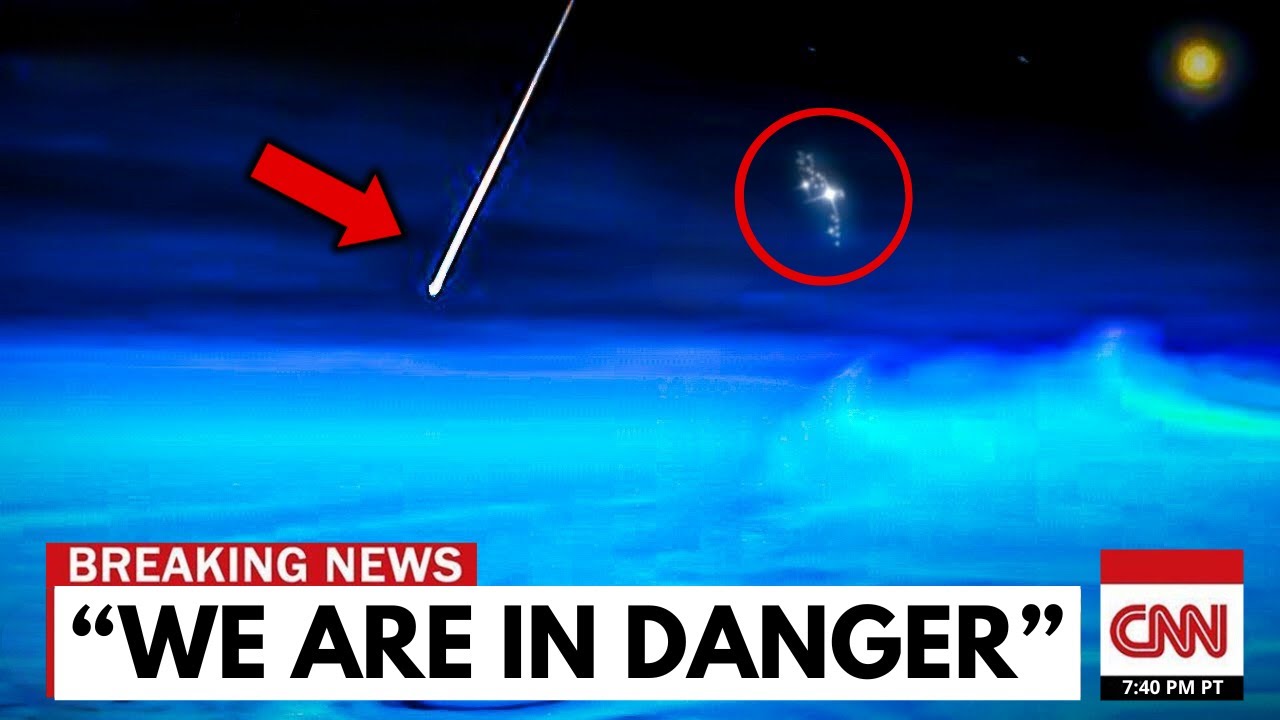James Webb Telescope CONFIRMS Neptune is NOT What We’re Being Told

At the farthest edge of the Solar System—where sunlight barely brushes against frozen clouds and gravity seems to forget its own laws—one planet has silently defied every expectation we’ve held. Neptune.
For over a century, it has stood as a distant sentinel, a cold gas giant cloaked in mystery, known only through equations, a fleeting Voyager flyby, and the occasional whisper through a telescope lens. But now, the James Webb Space Telescope—the most powerful eye humanity has ever turned toward the stars—has unveiled something so disturbing that it has shaken the scientific world to its core.
This wasn’t just an update. Not a sharper image. It was a warning. A red flag fluttering across the cosmos that what we thought we knew about Neptune… is dangerously, catastrophically wrong.
In a packed auditorium, under the glare of a global livestream, Neil deGrasse Tyson revealed the findings with the gravity of a man confronting the unknown. Neptune’s internal structure, its magnetic field, even its orbital mechanics—none of it aligned with Newtonian laws anymore.
Something was off. Deeply off. And not just strange—but terrifying. Because if Neptune, a planet we thought we understood, is harboring secrets radical enough to rewrite planetary science, then what else might be lurking behind the veil of our assumptions?
For years, astronomers had tracked Neptune’s orbit with robotic precision. Everything aligned—until it didn’t. New Webb data, paired with Earth-based interferometry arrays, exposed anomalies. Neptune’s trajectory began to deviate from Newton’s predictions. At first, scientists blamed the instruments. Then the software. But eventually, they faced a colder truth: Neptune was moving in ways that defied gravitational logic, as if it were responding to an invisible force—or worse, concealing one within.
And this… was only the beginning.
When Neil deGrasse Tyson stepped forward to explain what Webb had uncovered, the room didn’t fall silent out of awe—it fell silent out of fear. Beneath Neptune’s familiar blue swirls lies an internal structure unlike anything we’ve ever studied. Layers that disobey density and pressure. Thermal zones that generate heat without any input from the sun. Neptune behaves like a machine with a broken blueprint—or one operating on a set of physics we haven’t yet discovered.
Its magnetic field has always been strange: tilted, lopsided, misaligned with its core. But now, it’s shifting—not on geological time scales, but in human ones. The field fragments and recombines in dynamic cycles. Webb and supporting observatories detected magnetic surges—pulses—behaving in ways eerily similar to biological rhythms. These weren’t just fluctuations. They reacted. They evolved. They responded.
Some scientists began to whisper the unthinkable: What if Neptune’s magnetic field isn’t generated by a molten metallic core—but by something else entirely? Exotic superionic ices. A bizarre state of matter where water acts as both solid and liquid, conducting electricity like molten metal but arranged in a crystalline lattice.
Under Neptune’s crushing pressure, these superionic belts could flow in chaotic streams, driving storms, turbulence, and a magnetic map that redraws itself in real time. But even this wild theory couldn’t explain one thing—why Neptune’s magnetic field seems to react to solar events before they occur.
Unless Neptune isn’t just reacting. It’s predicting.
This is when things spiral into the unexplainable.
Neptune should be cold—frozen solid. It’s thirty times farther from the Sun than Earth. And yet, Webb’s thermal imaging revealed something impossible: deep within its atmosphere, beneath methane and ammonia clouds, warm patches persist—localized, growing, and without explanation. No tidal heating. No solar input. No known geological processes.
And still, Neptune burns from the inside out.
Some theorists now propose that the planet is experiencing internal thermal pulses—rogue waves of energy migrating through its body, perhaps even driving its hurricane-like storms. One hypothesis, whispered only among the boldest astrophysicists, suggests that these pulses are triggered by phase transitions in the superionic ice—matter flipping between states, unleashing bursts of energy.
If true, Neptune isn’t following physics. It’s generating its own.
A planet not in equilibrium—but in calculated chaos.
Then came the data that made the world stop.
From the heart of Neptune, buried in radio static, a signal was found. Not noise. Not random interference. A low-frequency pulse with spectral characteristics unlike anything found in natural planetary systems. It repeated. It oscillated. And then it disappeared.
But not before three independent observatories recorded it.
Scientists were divided. Was it a magnetic echo? A resonance from Neptune’s exotic chemistry? Or was it something else—something deliberate?
Some speculated that Neptune’s layered interior, if it includes stratified cavities or pressure-bending zones, might act like a resonant chamber. A natural amplifier. Or worse—a transmitter.
The possibility that Neptune is emitting a signal—not by accident, but on purpose—blew conventional models to pieces.
Because if that’s true… then Neptune might not be a planet at all. It might be a mechanism.
The Great Dark Spot—Neptune’s infamous storm system, a vortex the size of Earth—has long been known as one of the Solar System’s most violent weather systems. But Webb’s near-infrared imaging revealed something utterly unexpected.
The storm isn’t just persistent. It’s becoming adaptive. It shifts direction before solar winds arrive. Its temperature oscillates in harmonic frequencies. And its outer bands seem to exchange mass with nearby clouds in a rhythm resembling respiration.
One model even showed the storm’s core aligning—momentarily—with the planet’s magnetic field, as if in coordination. As if this wasn’t weather anymore.
It was behavior.
If hurricanes on Earth acted this way, meteorologists would declare them sentient.
So what happens… when a storm stops being just a storm?
As Webb continued its observations, a chilling geometric pattern emerged. At first, it was dismissed as artifact. But weeks of comparisons confirmed it: Neptune’s thermal pulses, magnetic anomalies, and inner ring orbits—all aligned with something called quasi-toroidal symmetry.
This isn’t random. It’s design—the kind of symmetry found in particle accelerators, energy fields, or propulsion systems.
But Neptune isn’t supposed to be a machine.
And yet… the pattern keeps appearing.
Pointing to the possibility that Neptune has an internal architecture—one that interacts with gravity in a way that lets it regulate its own chaos, its own orbit.
That raises the darkest question yet: Was Neptune formed this way… or made?
Then, amid the chaos, Webb detected a fluctuation in Neptune’s ring system. A faint object—or perhaps a shadow—moved against starlight. Invisible in visible light. But captured in infrared.
It wasn’t a moon. Or an asteroid. It was too symmetrical. Too smooth.
And most unsettling—it didn’t move.
Everything in the ring system orbits. But not this.
It sat there—motionless, as if watching.
Then… it vanished.
Not moved. Not ejected. Gone. Not into Neptune. Not into space. Just… disappeared.
Speculation exploded. Was it a cloaked satellite? A dormant probe? Or part of Neptune itself—like a sensor or a node?
One thing was certain: Neptune isn’t alone.
Either something is with it—or part of it was never what we thought.
Then came the observation that changed quiet concern into existential fear.
Using gravitational lensing, scientists detected a light distortion—not from Neptune’s mass—but from an off-axis region just above its equator. A subtle but measurable warping of spacetime. Not a moon. Not a cloud. But something bending gravity itself.
As if it were a micro–event horizon.
A miniature black hole? A gravity engine?
We don’t have the math to explain it. But we can detect it.
And that changes everything.
If Neptune hides something that can warp spacetime—it’s not a planet anymore.
It’s a cosmic enigma. A structure buried in ice and storms, operating on a scale we can barely perceive.
Maybe it was placed there. Maybe it formed naturally and was altered. Either way…
We were never meant to find it.
Neptune was supposed to be quiet. Distant. Frozen. A peaceful outpost at the edge of our celestial neighborhood. Where storms churn in silence and moons drift like forgotten sentinels.
But Webb pulled back the veil.
And what it revealed… isn’t just terrifying.
It’s paradigm-shattering.
Because this isn’t about weather. Or gas. Or rings.
This is about design.
About systems hidden in chaos. Motion that follows invisible laws. Signals embedded in planets.
And above all… the possibility that Neptune isn’t hiding a secret.
Neptune is the secret.
And what we just witnessed… might have been the lock turning.
If this discovery has shaken your understanding of the Solar System—you’re not alone. What James Webb found within Neptune’s storms is only the beginning.
Subscribe for real-time updates as we continue decoding the telescope that’s rewriting everything we know about space. Turn on notifications so you don’t miss the next pulse, flash—
Or whisper from the void.








